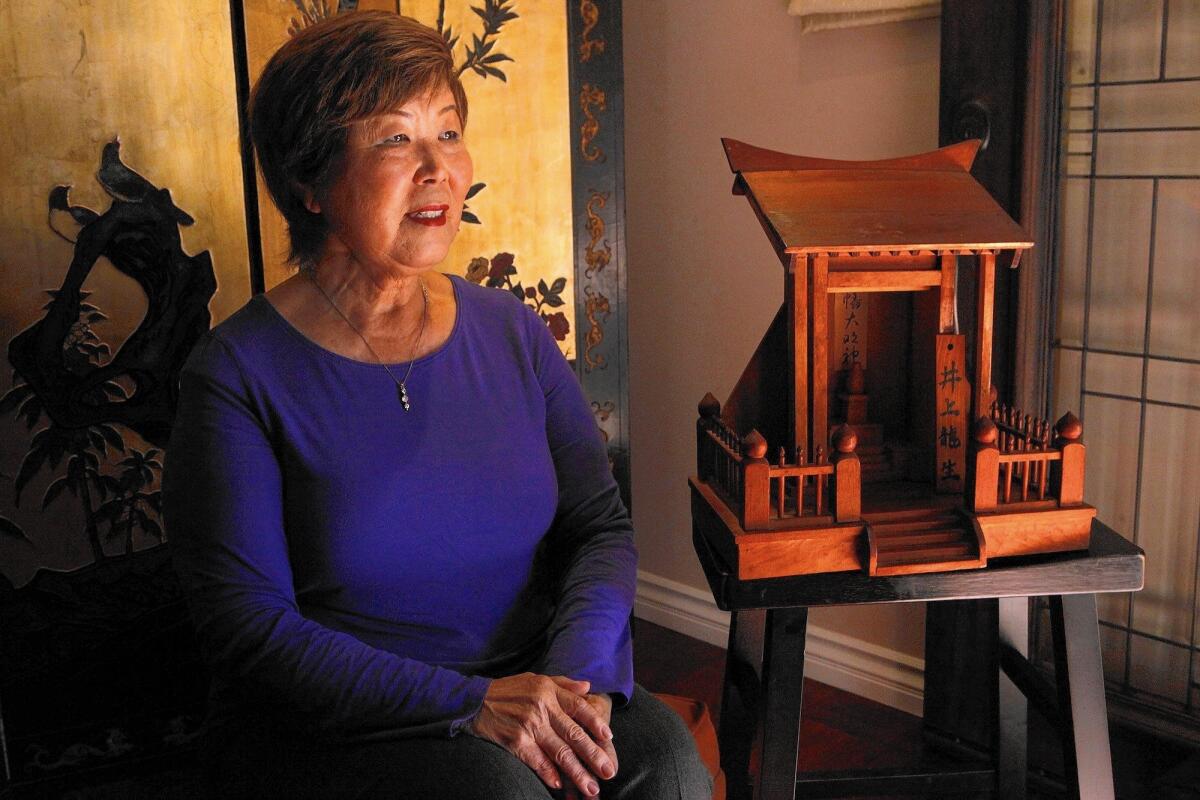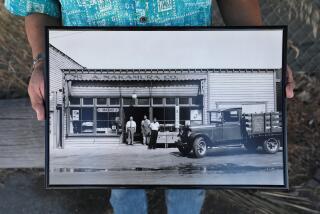Japanese Americans’ protests halt auction of internment camp items

Nancy Oda, who was born in an internment camp, fought to block the auction of historic items.
- Share via
Nancy Oda’s parents had an expression whenever she brought up her family’s imprisonment behind barbed wire during World War II. “They said ‘shikata ga nai—’ it can’t be helped,” recalls Oda.
But Oda, who was born in a relocation camp at Tule Lake near the California-Oregon border, won’t tolerate passivity anymore.
The retired Van Nuys school principal was among tens of thousands of Japanese Americans across the nation who jumped into action after learning that a rare collection of arts and crafts made in internment camps was being auctioned off, piece by piece.
In this case, at least, it could be helped.
The sale, set for Friday, was abruptly halted after attorneys enlisted by outraged former internees and their descendants threatened a lawsuit to stop it. Rago Arts and Auction Center in New Jersey on Wednesday said withdrawal of the collection would give concerned groups time to “come forward and secure it for education, display and research.”
Among the more than 450 items pulled from auction are handmade cigarette boxes, delicate bird brooches carved of wood, intricate family nameplates, a cat figurine shaped from tree roots, and watercolors of life inside the camps, including children playing in dirt lanes and outdoor assemblies.
Black-and-white photographs are also included showing such scenes as a husband and wife with a new baby, internees creating art, and rarely seen images of the barbed wire and watchtowers that marked the boundaries of life inside the camps.
Assembled by a folk art curator, the collection represents a tragic period of time for Japanese Americans, Oda says. In her own home sits a Shinto shrine, made of scrap lumber by her father while he was incarcerated. Oda, 69, and her siblings learned to bow to the altar before their father began judo lessons.
------------
FOR THE RECORD
April 16, 8:22 p.m.: An earlier version of this article referred to a Shinto shrine in Nancy Oda’s home as a butsudan. A butsudan is a Buddhist shrine.
------------
“In my generation, we know our rights and we feel that this is wrong to sell our memories and our history,” she said.
After Pearl Harbor was bombed by Japan in 1941, the U.S. rounded up and imprisoned 120,000 Japanese Americans, two-thirds of whom were U.S. citizens. They were held in 10 relocation camps across the West until the war ended in 1945.
Allen Hendershott Eaton, a collector who was sympathetic to the internees’ plight, began accumulating items from the camps late in the war, and his writings indicate that he intended to exhibit them. That never came about, but in 1952 Eaton used the collection as the basis for his book, “Beauty Behind Barbed Wire.”
The collection was passed down to Eaton’s heirs and eventually ended up in the possession of a family friend, who enlisted Rago to bundle them into 23 lots and auction them.
Word of the sale began to filter out after the New York Times ran a brief story March 6. Using email and social media, scores of Japanese American groups organized petitions and wrote letters to oppose the sale. Someone set up a Facebook page, “Japanese American History: NOT for Sale,” to organize the opposition.
The page had more than 6,200 followers by Thursday. Former Star Trek star George Takei, who has a huge following on social media, added his support.
Facebook commenters were savoring their victory.
“This is what can happen when a community unites and mobilizes!,” wrote Gann Matsuda.
The challenge now, said Greg Kimura, chief executive of the Japanese American National Museum in Los Angeles, is for internment scholars, cultural institutions and Japanese American activists to come together to decide what should happen to the collection.
“Our main concern about this, regardless of the legalities or the ethics, is that the artifacts end up in cultural institutions that have the ability to preserve them for the generations,” he said.
Rago officials echoed that theme, saying that the furor has emphasized the need for more discussion of what to do with historic and culturally sensitive items that are “the legacy of man’s inhumanity to man.” Personal items of former slaves and Holocaust victims could also fall into this category.
The issue “extends beyond what is legal,” Miriam Tucker, a Rago managing partner, said in a written statement. “It is something auction houses, galleries and dealers are faced with regularly.”
A foundation board representing the site of a former internment camp at Heart Mountain, Wyo., is expected to take a lead role in deciding where the collection is headed. In its threatened lawsuit, the foundation estimated the collection’s maximum value at $26,900. Shirley Higuchi, the foundation’s chairwoman, said it offered nearly twice that amount to keep the collection intact. But Rago had indicated that it would go ahead with the auction until late Wednesday, when it received the legal documents, she said.
“The only thing that stopped them was the threat of an injunction,” Higuchi said Thursday.
Kimura said the auction’s halt would allow time for “cooler heads to prevail.” The last time he saw the Japanese American community pull together with such unanimity, he said, was in the successful fight for the Civil Liberties Act of 1988, which granted redress payments to each surviving internee.
“We’re like every community — we tend to have our disagreements,” Kimura said. “But when it comes to the important things, we always rally together.”
Oda agreed. “I’m happy we’ve resolved this in an amicable way,” she said. “This took over everything I was doing yesterday.”
Then she left for another task — a meeting with a group of local Japanese Americans pushing to commemorate a former war relocation camp, this one in La Tuna Canyon near Tujunga.
More to Read
Sign up for Essential California
The most important California stories and recommendations in your inbox every morning.
You may occasionally receive promotional content from the Los Angeles Times.











